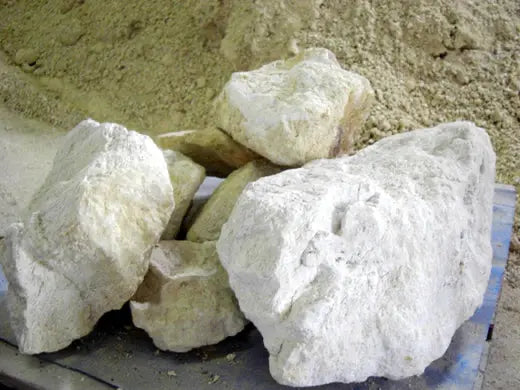From crushing raw materials to completion
we will introduce the process of creating Kutani ware. Craftsmen and artists pour their hearts and souls into crafting each piece. Please take a look at the inherited techniques of tradition.
STEP 1. Quarrying and Crushing

Quarrying Kutani ware clay from pottery stone sites in Komatsu City and Yamanaka Town, Ishikawa Prefecture.

Crushing clay stone into fine powder.
STEP 2. Water Straining and Kneading Clay

Excess moisture is removed, and impurities and iron content within the clay are eliminated.

STEP 3. Shaping

Handcrafted wheel-throwing for shaping. Allows for freeform design, including carving.

Mold-based casting for shaping. Used for larger sizes or intricate designs that are challenging with wheel-throwing.
STEP 4. Drying and Finishing

Drying is carried out in the sun or using drying machines. In a semi-dry state, detailed finishing touches are applied, including trimming the base, refining the exterior, and perfecting the edges.
STEP 5. Bisque Firing

Approximately 8 hours of firing at around 800°C, during which the grayish clay turns into a skin-tone base color.
STEP 6. Underglaze Painting

Using underglaze made primarily of cobalt oxide, the artist applies the design. This technique is commonly referred to as 'sometsuke'
STEP 7. Glazing

A uniform glaze coating is applied to the surface of the unglazed pottery. The glaze turns transparent and glassy after firing, covering the surface of the ceramic.
STEP 8. Final Firing

Today, many are produced using gas kilns, where they are industrially fired at a high temperature of around 1300°C for approximately 15 hours.
STEP 9. Overglaze Painting

It starts with Gosu (bone drawing), followed by the application of colors, mainly Kutani Five Colors, for overglaze painting

Each artist employs their own painting techniques and adds unique decorations.
STEP 10. Overglaze Kiln

The overglaze-painted items are fired using an overglaze kiln at a temperature of approximately 800°C.

Depending on the product, they are fired for a minimum of 4 hours up to a maximum of 10 hours to complete the finishing process.
Completion

